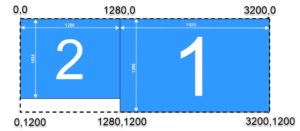Civil 3D has many dialogs boxes that are “modeless” and can be left floating on the main or a secondary monitor or remain docked in the Civil 3D application window. Most of these windows are referred to as palettes. Modeless windows don’t block the main window, so palettes can be left open on multiple monitors and focus can be switched freely between the main window and the palettes.
While this can make for a very productive software environment, the palettes are independent of the main window and can actually become “lost” in certain situations. Normal palette behavior is when Civil 3D is opened, any palettes that were left open when Civil 3D was last closed will appear in the same state and position on the screen as they were before. A palette becomes “lost” when it no longer appears in the same state or position on screen and is either completely or partially off-screen and cannot be moved back onto a screen.
Civil 3D remembers the X, Y coordinate origin of a palette, and the size in pixels of a palette when the application is closed. The most common situation for palettes to become “lost” is closing Civil 3D on one set of monitors and then opening Civil 3D with a completely different set of monitors. This can cause a problem because, in Windows, the coordinates of the screens span all screens, not each individual screen. All monitors as a whole are assigned a virtual screen coordinate system. Coordinate 0,0 begins at the upper left corner of the leftmost monitor and all other monitor coordinates are relative to that position. The virtual screen is a bounding box of all monitors, the smallest rectangle that encloses all the monitors.

Virtual Screen Coordinate System
Using a computer with different monitor setups and monitor settings can create a situation where the virtual screen coordinate system completely changes. Palettes can become “lost”, because a previous palette coordinate in the virtual space does not guarantee that the remembered location in a different virtual space is actually visible on any monitor.
Here are a few possible situations resulting in “lost” palettes:
• Civil 3D was closed with a different number of monitors than when it was reopened.
• The positions of the monitors were different when Civil 3D was reopened than when Civil 3D was closed.
• The monitor resolutions when Civil 3D was closed were different than the monitor resolutions when Civil 3D was reopened.
• Multiple monitors that have different text scaling settings can cause program issues in Civil 3D. Windows 10 likes to set text scaling for high-resolution monitors to 125% by default. Set all monitors to 100% to avoid issues.
If you are going to be using different monitor setups frequently, to avoid losing palettes, move the Civil 3D application window and all palettes to the main monitor before closing Civil 3D.
If your palettes are already “lost” it’s not too hard to get them back. Most of the time, unhooking any secondary monitors and opening Civil 3D on the main monitor will bring the palettes back:
1. Unhook all secondary monitors or disconnect them in the Windows display settings.
2. Open Civil 3D. The application window and any open palettes should all return to the main monitor.
3. Close all open palettes and close Civil 3D on the main monitor. (This will reset the position of the palettes relative to the upper left of the main monitor.)
4. Hook any secondary monitors back up and open Civil 3D.
5. Verify the palettes are now visible when opened.
If the above does not work and there are still “lost” palettes, you may have to “retrieve” them from the last monitor where they appeared. This occurs most often if a palette is on a secondary monitor and the positions and resolutions of the monitors were different when Civil 3D was closed than when re-opened. (For example, closed on two stacked monitors with different resolutions and opened on two side-by-side monitors with different resolutions.) To retrieve a lost palette that does not return to the main monitor:
1. Return to the last monitor setup and hook the monitors up the same as before. (Or hook up any set of monitors in the exact same configuration, positions, and resolutions.)
2. Open Civil 3D. The palettes should be visible on the monitor where they were last located.
3. Move the palette(s) onto the main monitor, close the palette(s), and close Civil 3D.
4. Unhook all secondary monitors or disconnect them in the Windows display settings.
5. Open Civil 3D and verify the palettes are now visible when opened.

Another option I’ve used to reset “lost” palettes that works if you don’t use the out-of-the-box (OOTB) profile as your default profile.
1) Open with the OOTB profile using the Start Menu shortcut.
2) Open the missing palette.
3) Move it.
4) Close it.
5) Reopen it.
6) Switch to your company profile in Options > Profiles.
7) Repeat the move, close, reopen process.
8) Close the application.
9) Reopen the application and look for the palette that was missing. You might have to relaunch the palette to make it appear depending on your workspace settings.